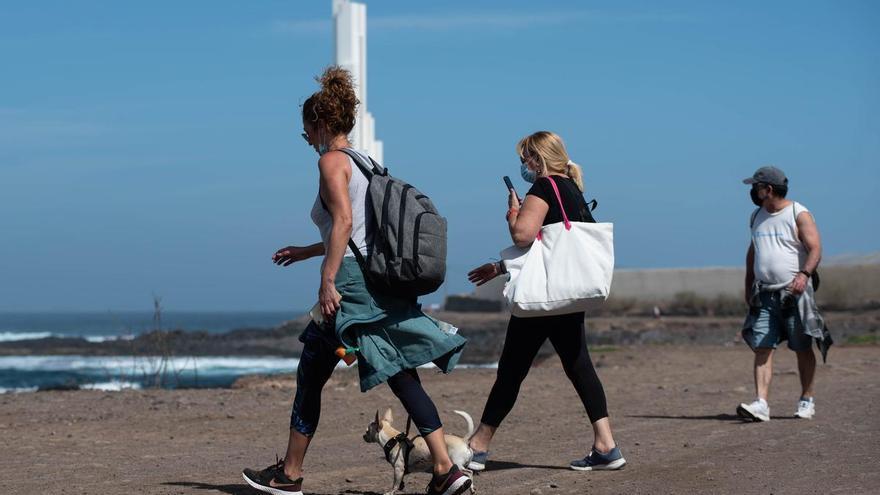
The Association for Environmental and Consumer Education (Adeac) has delivered its Sendero Azul flags this Friday, with which it has recognized 104 throughout Spain and three of them are in the Canary Islands, specifically on the islands of Tenerife, The Palm and Gran Canaria.
The 104 distinctions of this year there are 22 more than last year and they recognize trails that already cover 600 kilometers in up to 83 municipalities, 20 provinces and ten autonomous communities, as explained by the president of Adeac, José Palacios.
This year, 104 itineraries located in the autonomous communities of the Balearic Islands, Islas Canary Islands, Valencian Community, Cantabria, Asturias, Extremadura, Catalonia, Murcia and Andalusia. This association promotes this recognition on an annual basis with the aim of recovering and enhancing trails and itineraries throughout the national territory.
Coastal path of La Punta del Hidalgo (Tenerife)
- Length: 2,300 m.
- Duration: 45 min.
- difficulty: easy
The Sendero Litoral del Faro de La Punta del Hidalgo, also known as Camino de la Costa or Camino de San Juanito, is located in the municipality of La Laguna and in it we can discover one of the best areas of the north coast of Tenerife.
This path begins in the Paya del Roquete, next to the Fishermen’s Guild of Our Lady of Consolation in Punta del Hidalgo, and reaches the Hermitage of San Juanito, passing by the Lighthouse and the Charco La Arena, a old natural marine pool for public use.
Time Trail (La Palma)
- Length: 1,650 m.
- Duration: 40 min.
- difficulty: medium
The Sendero Azul Puerto de Tazacorte – El Time Trail is one of the busiest trails on the island of La Palma. This path has had a special importance in the last five centuries because, through this road, communications between the Port of Tazacorte and the north and northwest of the island of La Palma were facilitated. There is nothing to prevent this road from existing in the pre-Hispanic period, since it is the fastest way to get from the coast of Tazacorte to Time.
The path goes through a series of natural caves that would be used by the Benahoritas, the aborigines of La Palma, to live, as many of the inhabitants of the Port of Tazacorte have continued to this day.
El Confital Bay (Gran Canaria)
- Length: 6,850 m.
- Duration: 1h 40 min.
- difficulty: easy
The Sendero Azul de la Bahía del Confital and las Canteras beach run along a coastal area declared a Special Conservation Zone due to the presence of various habitats of community interest, such as sandbanks permanently covered by shallow seawater, reefs and submerged or semi-submerged sea caves, in addition to finding various protected species, such as the loggerhead turtle (Caretta caretta) or the bottlenose dolphin (Tursiops truncatus).
Another of the curiosities of this edition is that, for the first time, the flag has been delivered to a path promoted by a university, that of A Coruña (UDC), which has been collected by its rector, Julio Abalde.
During the act, the president of Adeac pointed out that the reasons for choosing Galicia and, more specifically, Santiago as host, are its first position as a community “with the greatest number of flags” and also because the Galician capital is “the goal possibly the best known trail in the world”.
As he has expressed, for 12 centuries “millions of people” have traveled the Camino de Santiago and have discovered that in addition to its spiritual and cultural component, there is a natural and patrimonial wealth and have entered into a process of communication with others that is ” matchless”.
For his part, the president of the Xunta, Alfonso Rueda, who closed the event, recalled that these blue trails are “much more than hiking trails” and that they are itineraries that make up “a set of values”.
In addition, Rueda has claimed that these badges also serve to recognize those who work for “sustainable tourism.”
“This is not about thinking that if you take care of the environment you have to give up economic activity. On the contrary,” reflected Rueda, who highlighted the potential of blue flag roads to attract travelers and strengthen the tourism sector.
The president of the Xunta has stressed that Galicia “is the Way” above all, but that it is also crossed by hundreds of trails that weave a network that identifies the Community with the nature in which it lives and with which it coexists.















